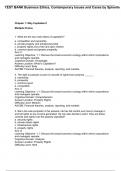TEST BANK Business Ethics, Contemporary Issues and Cases by Spinello
Chapter 1: Why Capitalism?
Multiple Choice
1. What are the two main pillars of capitalism?
a. competition and ownership
b. private property and entrepreneurship
c. property rights and a free and open market
d. common good and greater prosperity
Ans: C
Learning Objective: 1.1: Discuss the broad economic ecology within which corporations
and managers operate.
Cognitive Domain: Knowledge
Answer Location: What Is Capitalism?
Difficulty Level: Easy
AACSB: Financial theories, analysis, reporting, and markets
2. The right to possess is part of a bundle of rights that comprise ______.
a. ownership
b. prosperity
c. common good
d. competition
Ans: A
Learning Objective: 1.1: Discuss the broad economic ecology within which corporations
and managers operate.
Cognitive Domain: Comprehension
Answer Location: Property Rights
Difficulty Level: Medium
AACSB: Financial theories, analysis, reporting, and markets
3. Sal is the sole proprietor of his pizzeria. He has full control over how to manage it,
and full rights to any income generated. He can also decide to sell it. How are these
controls and rights over the pizzeria classified?
a. security rights
b. private citizen rights
c. infrastructure rights
d. property rights
Ans: D
Learning Objective: 1.1: Discuss the broad economic ecology within which corporations
and managers operate.
Cognitive Domain: Analysis
Answer Location: Property Rights
Difficulty Level: Hard
, Spinello, Business Ethics
AACSB: Financial theories, analysis, reporting, and markets
4. What is the difference between capitalism and communism?
a. In a capitalist market, the good of production can be owned by private companies or
individuals.
b. In a communist economy, so-called capital goods are owned by private companies.
c. In a communist economy, natural resources are owned by private individuals or
companies.
d. In a capitalist market, natural resources are owned solely by the government.
Ans: A
Learning Objective: 1.1: Discuss the broad economic ecology within which corporations
and managers operate.
Cognitive Domain: Analysis
Answer Location: Property Rights
Difficulty Level: Hard
AACSB: Financial theories, analysis, reporting, and markets
5. Which kind of market has no restrictions on what people can own?
a. capitalist
b. communist
c. laissez-faire
d. socialism
Ans: C
Learning Objective: 1.1: Discuss the broad economic ecology within which corporations
and managers operate.
Cognitive Domain: Comprehension
Answer Location: Property Rights
Difficulty Level: Medium
AACSB: Financial theories, analysis, reporting, and markets
6. An insurance company sells its policies to people who need coverage. In exchange
for a premium paid by the customer, the insurer provides insurance coverage. The free
choice of the two parties to engage in the exchange is an example of ______.
a. competition
b. a market
c. customer preference
d. demand
Ans: B
Learning Objective: 1.1: Discuss the broad economic ecology within which corporations
and managers operate.
Cognitive Domain: Application
Answer Location: Free and Open Market
Difficulty Level: Medium
AACSB: Financial theories, analysis, reporting, and markets
,7. What determines the market price and efficient quantity for every commodity in a
well-functioning market?
a. supply and demand
b. invisible hand
c. natural effort
d. social good
Ans: A
Learning Objective: 1.1: Discuss the broad economic ecology within which corporations
and managers operate.
Cognitive Domain: Knowledge
Answer Location: Free and Open Market
Difficulty Level: Easy
AACSB: Financial theories, analysis, reporting, and markets
8. Which is a driving force behind capitalism?
a. altruism
b. self-interest
c. generosity
d. self-sacrifice
Ans: B
Learning Objective: 1.1: Discuss the broad economic ecology within which corporations
and managers operate.
Cognitive Domain: Comprehension
Answer Location: Free and Open Market
Difficulty Level: Medium
AACSB: Financial theories, analysis, reporting, and markets
9. When there are minimal entry barriers to a market and competition coordinates
individual efforts, one can conclude that the market is ______.
a. failing
b. struggling
c. well-functioning
d. controlled
Ans: C
Learning Objective: 1.1: Discuss the broad economic ecology within which corporations
and managers operate.
Cognitive Domain: Analysis
Answer Location: Free and Open Market
Difficulty Level: Hard
AACSB: Financial theories, analysis, reporting, and markets
10. True capitalism leverages the power of ______ to serve the diverse needs of
producers and consumers.
a. investors
b. system
c. technology
, d. competition
Ans: D
Learning Objective: 1.1: Discuss the broad economic ecology within which corporations
and managers operate.
Cognitive Domain: Knowledge
Answer Location: Free and Open Market
Difficulty Level: Easy
AACSB: Financial theories, analysis, reporting, and markets
11. The recognition of private property rights is a common feature of all categories of
______.
a. capitalism
b. socialism
c. communism
d. primitivism
Ans: A
Learning Objective: 1.1: Discuss the broad economic ecology within which corporations
and managers operate.
Cognitive Domain: Analysis
Answer Location: Archetypes of Capitalism
Difficulty Level: Hard
AACSB: Financial theories, analysis, reporting, and markets
12. A government owning a majority share of a company is an example of which type of
capitalism?
a. oligarchic
b. state-guided
c. big-firm
d. entrepreneurial
Ans: B
Learning Objective: 1.1: Discuss the broad economic ecology within which corporations
and managers operate.
Cognitive Domain: Application
Answer Location: Archetypes of Capitalism
Difficulty Level: Medium
AACSB: Financial theories, analysis, reporting, and markets
13. Which two types of capitalism are more prone to corruption?
a. big-firm and oligarchic
b. oligarchic and state-guided
c. entrepreneurial and big-firm
d. state-guided and entrepreneurial
Ans: B
Learning Objective: 1.1: Discuss the broad economic ecology within which corporations
and managers operate.




